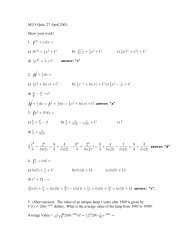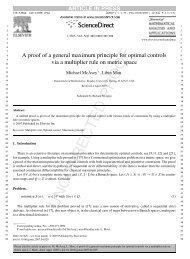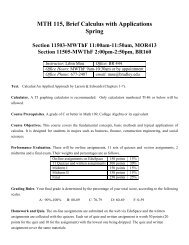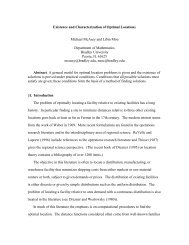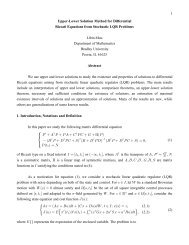1 Upper-Lower Solution Method for Differential Riccati Equations ...
1 Upper-Lower Solution Method for Differential Riccati Equations ...
1 Upper-Lower Solution Method for Differential Riccati Equations ...
You also want an ePaper? Increase the reach of your titles
YUMPU automatically turns print PDFs into web optimized ePapers that Google loves.
(ii) Equation (1) has a solution T with eaT b ! if and only if it has an upper solution ] with<br />
ea] b !.<br />
14<br />
Proof. The necessity in both cases is trivial. To show the sufficiency in both cases, use Proposition 8 to<br />
conclude that equation (1) has an upper solution ] (lower solution ^ ) with ea] b ž! ( ea^ b !). So<br />
equation (1) has a solution T with eaTb ž! ( !, respectively) by Theorem 11. ¨<br />
Theorem 12 is not true under the weaker assumptions ea^ b ! or ea] b Ÿ !. Consider the<br />
scalar case of equation (1) with Eœ "ß FœKœ R œ"ß GœHœVœWœ!ß C œ! ; that is,<br />
w<br />
T €" #T œ!ß T a> b œ" . Obviously, ! is a lower solution. It is feasible because ea! b œ fa! b œ! .<br />
"<br />
" "<br />
However, the solution T ab > œ<br />
#<br />
€<br />
#/ #> is not feasible because eaTb œ! but faTb<br />
œT.<br />
It is proved in<br />
X<br />
[8, Thm 4.1] that (1) has a solution T with eaT b ž ! if Wœ! , H Hž! and ! is a strict lower solution<br />
with ea! b œV ! (e.g., V !, K !, R ! and either K ž ! or R ž! ). Next theorem generalizes<br />
this result to equation (1) with an arbitrary lower solution. Our proof is based on Theorem 12.<br />
Theorem 13. Recall eaR b œ V a> b€H a> bR Ha> b. Suppose HHž!<br />
X X<br />
" " "<br />
.<br />
(i) If eaRb ž! and ^ is a strict lower solution to (1) with ea^ b !, then (1) has a solution T with<br />
eaT b ž !.<br />
(ii) If eaR b ! and ] is a strict upper solution to (1) with ea] b Ÿ !, then (1) has a solution T with<br />
eaT b !.<br />
Proof. By Remark 3, we show (i) only. We first assume Wœ! and ^ œ! . In this case the assumption<br />
implies that V ! and either K ! or R ! is strict. We will show that (1) has another lower solution<br />
^+ ž ! in Ò> ! ß> " Ñ with ea^+<br />
b ž ! in Ò> ! ß><br />
" Ó. Then by Theorem 12, (1) has a solution T with eaT b ž !.<br />
!a><br />
><br />
If R ž! , then let ^+ œ &/ " bI8, where I8<br />
is the 8‚8 unit matrix, & is the minimum<br />
!a> ><br />
eigenvalue of R and ! is an undetermined number. Using that e a^ b &/<br />
" b X<br />
HHž! , we have<br />
+ ´ +<br />
w !a> + +<br />
> " b<br />
X a^ b ^ € LQ a^ b€ Ca^ b &/ Q€K,<br />
X X X X X X X X<br />
where Qœ ! I 8 €E €E€G G aF €HGbaHHb aF €HG b€ CaI<br />
8 bÞ Taking a<br />
sufficiently large ! so that Qž! , we have Xa^+ b ž! as desired.<br />
"ß_ 8<br />
If K ž! , then let ^+ œ & ^ ! ab > , where & ž! and ^! P aMß’<br />
b such that ^ ! a> " b œ R and<br />
^ ab > ž! <strong>for</strong> >Ò> ß> Ñ.<br />
Using that e a^ b &ea^ b ž! in Ò> ß><br />
Ó, we have<br />
! ! " +<br />
! ! "<br />
w<br />
+ +<br />
+ +<br />
"<br />
+<br />
X a^ b ´ ^ € LQa^ b€ C a^ b œ & Q€K, (39)<br />
X X X<br />
where Qœ ^! €E ^! € ^! E€G ^! G fa^! b ea^! b fa^! b€<br />
Ca^!<br />
b Þ Since Kž! we can<br />
make X a^+ b ž! by taking a sufficiently small & ž! .<br />
"



